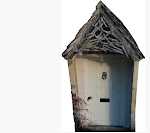Last night I had the wonderful pleasure of settling into the darkness of a cinema and being transported into the fantastical world of
Doctor Parnassus. The early reviews I'd read had lead me to believe I would probably be disappointed by the film - and I'm not going to link to any of them here because they were wrong - it's an imaginative masterpiece!
The story is about Doctor Parnassus, a man who won immortality in a bet with the Devil, and who later, to regain his youth and win the love of a beautiful young woman, made another deal - promising to give the Devil any child he fathered once they reached the age of sixteen. Now he must win another wager with the Devil if he is to save his daughter Valentina.
For me this felt like a truly modern fairy tale; there were many echoes from older tales: the parent who has offered up their first born child as payment for what they want at the time; an unwise bargain with the devil; a character who plays a pipe and has a dubious association with a children's charity (which made me think of the
Pied Piper). True to the fairy tale form, the magic of a mirror - which is the entrance to the imaginarium - is never questioned, and once someone has stepped through the mirror the world beyond is furnished by their own imagination. This leads to some wonderful settings, including a dark forest of stage prop trees, and ladders which reach up to the clouds...
But the real world is never far away; Doctor Parnassus' imaginarium is housed on a rickety theatre on wheels (read about what inspired it
here) and is pulled through modern London's streets by horses. As well as the familiar tourist sites we are treated to the bleaker side of inner-city life - derelict buildings, the streets at pub chucking out time; a Homebase car park.
The corrupt Tony is
clearly a comment on our despicable ex-prime minister - at one point we even see a front page from a tabloid with the character Tony's face where Blair's should be, the headline: 'Tony Liar'. Similarly a song and dance scene by violent policemen, which felt very close to
Monty Python in style, had especially powerful resonance when I thought of the
documented police violence at the G20 protests in April this year.
The film is flawlessly acted by a great ensemble
cast, and it's visually stunning - after watching this film I can finally see the point of cgi; misapplied by so many films trying to create realistic versions of reality - here it is used wonderfully to create impossible worlds.
This is a film made with love, against the odds; as has been well documented both
Heath Ledger and one of the film's producers,
Bill Vince, died during production and the film struggled to find funding - a case of small-minded money men with no vision always taking the easier routes through life - and as
Terry Gilliam has explained this was part of the inspiration behind the story. Most of all though this is a film about storytelling and the power of the imagination - as Parnassus at one point realises - 'the Universe is sustained by story'.
Doctor Parnassus is out at UK cinema's now -
here is the official UK site.
The film is set for a Christmas release in the US -
here is the US site.
The
Doctor Parnassus Support Site has a list of other countries official sites, more information on release dates, and info about how you can help support this wonderful film by getting cinemas to show it.
There is also a
not to be missed Doctor Parnassus section on Dreams, the online
Terry Gilliam fanzine, which includes brilliant interviews, artwork, stills and clips.

























